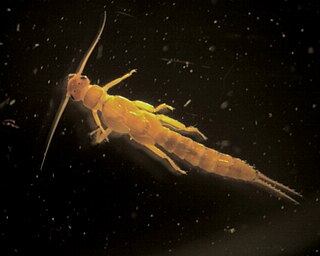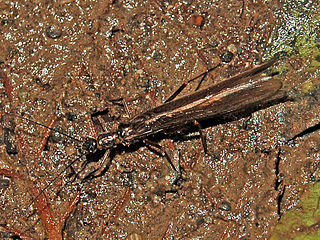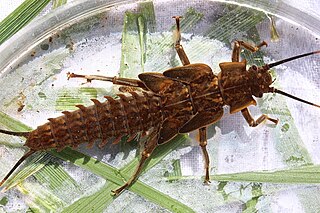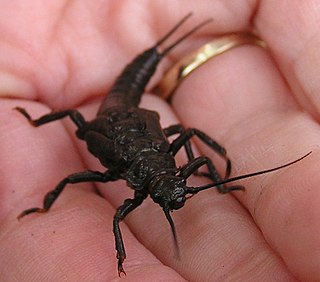
Plecoptera is an order of insects, commonly known as stoneflies. Some 3,500 species are described worldwide, with new species still being discovered. Stoneflies are found worldwide, except Antarctica. Stoneflies are believed to be one of the most primitive groups of Neoptera, with close relatives identified from the Carboniferous and Lower Permian geological periods, while true stoneflies are known from fossils only a bit younger. Their modern diversity, however, apparently is of Mesozoic origin.

Aquatic insects or water insects live some portion of their life cycle in the water. They feed in the same ways as other insects. Some diving insects, such as predatory diving beetles, can hunt for food underwater where land-living insects cannot compete.

The Peltoperlidae, also known as roach-like stoneflies or roachflies, are a family of stoneflies.

The Perlodidae, also known as the perlodid stoneflies, stripetails, or springflies, are a family of stoneflies.

Pteronarcys californica is a species of insect in the family Pteronarcyidae, the giant stoneflies and salmonflies. It is known commonly as a salmonfly. Salmonflies are an important aquatic insect for fly anglers and many nymph and adult fly patterns are tied to imitate this insect.

The Capniidae, the small winter stoneflies, are a family of insects in the stonefly order (Plecoptera). It constitutes one of the largest stonefly families, containing some 300 species distributed throughout the holarctic. Their closest relatives are the rolled-winged stoneflies (Leuctridae).

Chloroperlidae are a family of stoneflies, commonly known as green stoneflies, with more than 200 species and 22 genera. They appear green to yellow in colour, and are popularly used among fisherman as bait for trout fishing. Green stoneflies live in the benthic zone of the cold streams and rivers of five continents and four zoogeographical regions, emerging from the water to live in the riparian zone as adults. They are sensitive to pollutants, making them an indicator species for determining the quality of water bodies. Chloroperlidae are hemimetabolous, having no pupal stage, but instead hatch from eggs as nymphs and mature directly into adults. They are omnivorous, feeding on small organisms and plant particles, and become more carnivorous as they mature. The classification of Chloroperlidae is contested, with some believing that they should be considered as members of different orders, as opposed to the order Plecoptera that they currently belong to.

Ithonidae, commonly called moth lacewings and giant lacewings, is a small family of winged insects of the insect order Neuroptera. The family contains a total of ten living genera, and over a dozen extinct genera described from fossils. The modern Ithonids have a notably disjunct distribution, while the extinct genera had a more global range. The family is considered one of the most primitive living neuropteran families. The family has been expanded twice, first to include the genus Rapisma, formerly placed in the monotypic family Rapismatidae, and then in 2010 to include the genera that had been placed into the family Polystoechotidae. Both Rapismatidae and Polystoechotidae have been shown to nest into Ithonidae sensu lato. The larvae of ithonids are grub-like, subterranean and likely phytophagous.

The Leuctridae are a family of stoneflies. They are known commonly as rolled-winged stoneflies and needleflies. This family contains at least 390 species.

Parks' Salmonfly is a traditional dry fly imitating adults of the family of giant stoneflies or salmonflies (Pteronarcyidae). The most commonly imitated species is Pteronarcys californica or salmonfly common throughout Western North America from British Columbia to California.

Pteronarcys biloba, the knobbed salmonfly, is a species of giant stonefly in the family Pteronarcyidae. It is found in North America.

Pteronarcys is a genus of giant stoneflies in the family Pteronarcyidae. There are about 8 described species in Pteronarcys.

Pteronarcys princeps, the ebony salmonfly, is a species of giant stonefly in the family Pteronarcyidae. It is found in North America.

Pteronarcys pictetii, the midwestern salmonfly, is a species of giant stonefly in the family Pteronarcyidae. It is found in North America.

Pteronarcys dorsata, the American salmonfly, is a species of giant stonefly in the family Pteronarcyidae. It is found in North America. Larva feed on algae, but adults don't eat at all. They are known to release a noxious fluid from joints in the legs or play dead when menaced and are primarily nocturnal. Adults are active in spring and summer and the species is the biggest stonefly in North America.
Pteronarcella regularis, the dwarf salmonfly, is a species of giant stonefly in the family Pteronarcyidae. It is found in North America.
Pteronarcella is a genus of giant stoneflies in the family Pteronarcyidae. There are at least two described species in Pteronarcella.
Pteronarcella badia, the least salmonfly, is a species of giant stonefly in the family Pteronarcyidae. It is found in North America.
Notonemouridae is a family of stoneflies in the order Plecoptera. There are more than 20 genera and at least 120 described species in Notonemouridae.

Salmon fly patterns are an important collection of artificial flies used by fly anglers to imitate nymphal and adult forms of Pteronarcys californica a giant stonefly or salmon fly. Salmon flies are common in high gradient, freestone rivers and streams from Western Canada throughout the Western U.S. to Mexico in the Rocky Mountains and coastal mountain ranges. Nymphs live for three to five years before adult emergence which typically occurs in late Spring or early summer. The long lifespan of the nymphal form provides year-round angling opportunities for fly anglers.














